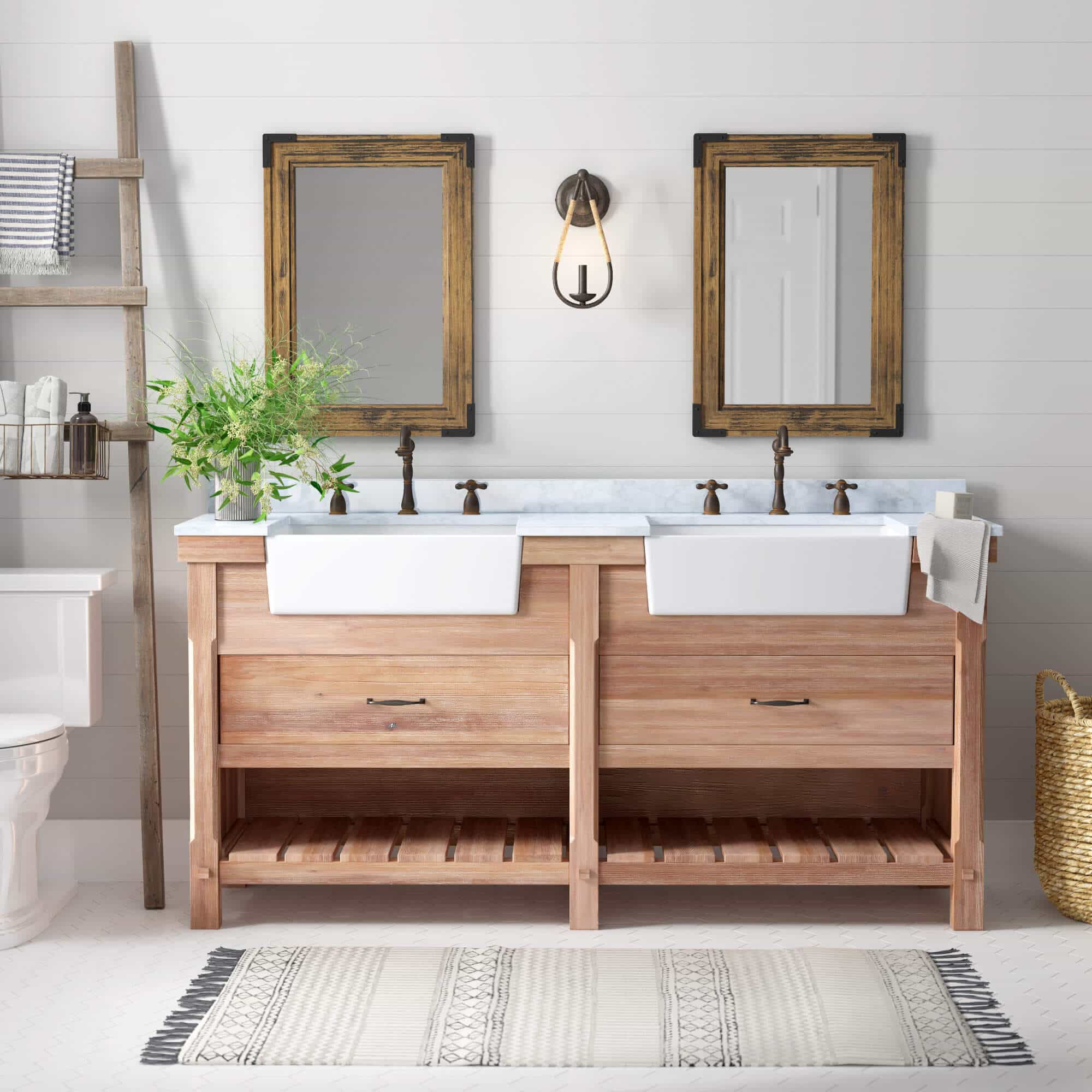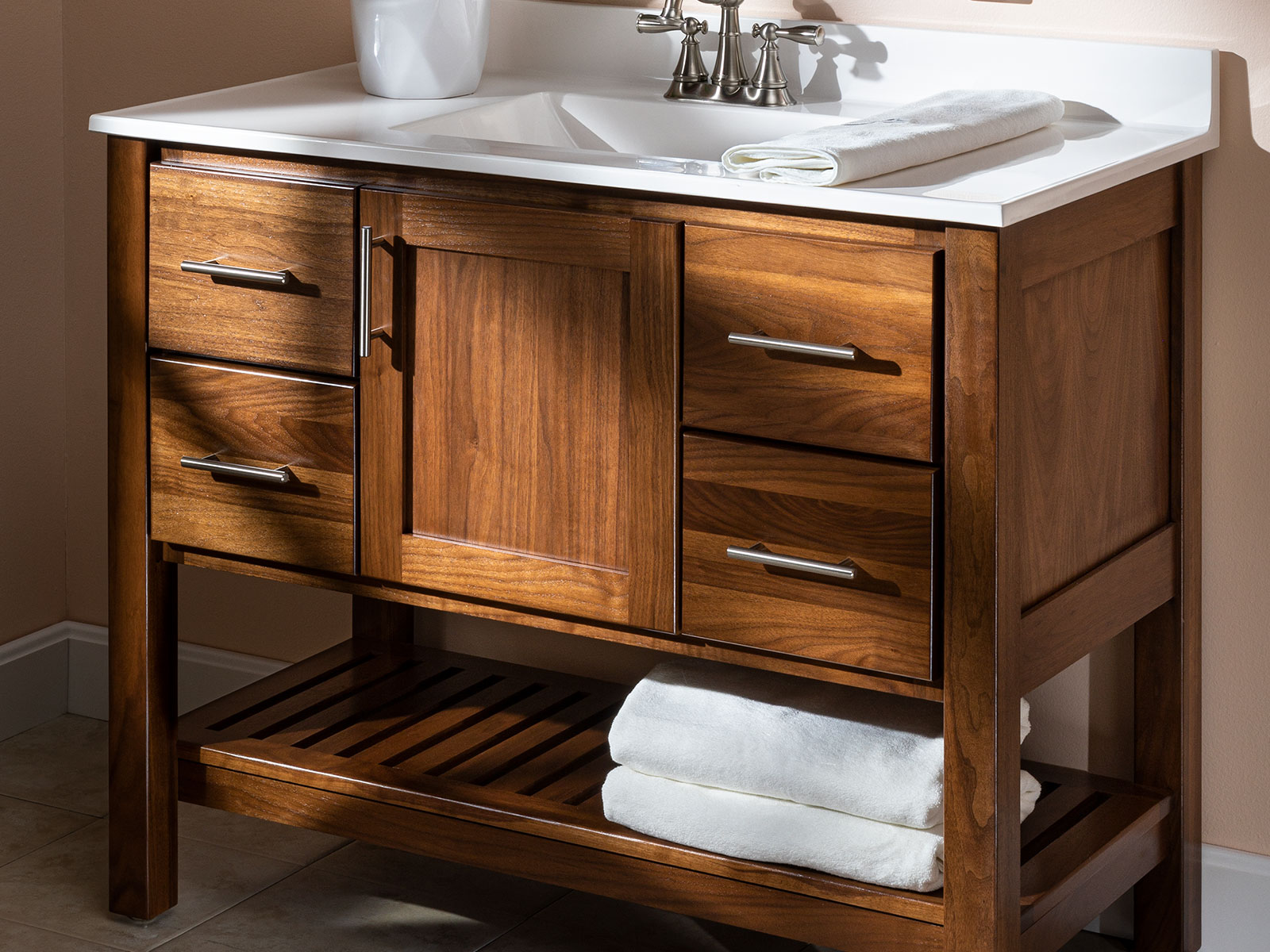Types of Bathroom Vanities That Look Like Furniture

Transforming your bathroom into a haven of style and comfort often involves incorporating furniture-like vanities that seamlessly blend with your décor. These vanities go beyond mere functionality, adding a touch of elegance and sophistication to your space.
Traditional Bathroom Vanities
Traditional bathroom vanities draw inspiration from classic design elements, often featuring intricate carvings, ornate details, and a timeless aesthetic. They typically showcase warm wood tones, such as cherry, mahogany, or oak, and incorporate traditional hardware like brass or bronze pulls. These vanities often feature a pedestal base, a double sink with a large countertop, and decorative moldings.
Modern Bathroom Vanities
Modern bathroom vanities embrace clean lines, minimalist designs, and a focus on functionality. They typically feature sleek, geometric shapes, often with a combination of wood and metal elements. Modern vanities often feature a floating design, which creates a sense of spaciousness and lightness. They may incorporate materials like glass, acrylic, or stainless steel, along with contemporary hardware.
Farmhouse Bathroom Vanities
Farmhouse bathroom vanities evoke a rustic charm, blending functionality with a sense of warmth and comfort. They often feature distressed wood finishes, such as reclaimed barnwood or weathered oak, and incorporate elements like open shelving, farmhouse sinks, and metal accents. These vanities often feature a simple, rectangular design with a focus on natural materials.
Contemporary Bathroom Vanities
Contemporary bathroom vanities combine modern and traditional elements, creating a unique and stylish aesthetic. They often feature a mix of materials, such as wood, metal, and stone, and incorporate clean lines, geometric shapes, and bold colors. Contemporary vanities may feature unique hardware, such as brushed nickel or black matte finishes, and often incorporate a mix of open and closed storage.
Materials and Finishes

Bathroom vanities that look like furniture are crafted from a variety of materials, each offering distinct advantages and disadvantages in terms of durability, aesthetics, and maintenance. The choice of material ultimately depends on your budget, style preferences, and the overall design of your bathroom.
Wood
Wood is a popular choice for bathroom vanities due to its natural beauty, warmth, and versatility.
- Durability: Wood is a durable material that can withstand everyday wear and tear. However, some woods are more resistant to moisture than others. For example, hardwoods like oak, maple, and cherry are known for their durability and resistance to moisture, while softwoods like pine and cedar are more susceptible to warping and rotting.
- Aesthetics: Wood comes in a wide range of colors, grains, and finishes, allowing for a wide range of aesthetic possibilities. The natural beauty of wood can create a warm and inviting atmosphere in your bathroom.
- Maintenance: Wood requires regular maintenance to keep it looking its best. This includes cleaning, sealing, and refinishing. However, with proper care, a wooden vanity can last for many years.
Metal
Metal vanities are becoming increasingly popular, offering a modern and industrial look.
- Durability: Metal is a durable material that is resistant to moisture, scratches, and dents.
- Aesthetics: Metal vanities can be finished in a variety of colors and styles, from sleek and polished to rustic and distressed.
- Maintenance: Metal vanities are relatively easy to maintain. They can be cleaned with a damp cloth and mild detergent.
Stone
Stone vanities offer a luxurious and elegant look.
- Durability: Stone is a durable material that is resistant to moisture, scratches, and heat. However, it can be susceptible to chipping and cracking if not properly cared for.
- Aesthetics: Stone vanities come in a wide range of colors, patterns, and textures, from sleek and polished to rustic and textured.
- Maintenance: Stone vanities require regular sealing to protect them from stains and moisture. They should also be cleaned with a mild detergent and a soft cloth.
Engineered Materials
Engineered materials, such as MDF (Medium-Density Fiberboard) and plywood, are often used in the construction of bathroom vanities.
- Durability: Engineered materials are generally durable and resistant to moisture. However, they are not as durable as solid wood.
- Aesthetics: Engineered materials can be finished to resemble wood or other materials, offering a wide range of aesthetic possibilities.
- Maintenance: Engineered materials are relatively easy to maintain. They can be cleaned with a damp cloth and mild detergent.
Finishes
The finish of your vanity can significantly impact its overall look and feel.
- Paint: Paint is a versatile finish that can be used to create a wide range of looks, from classic and traditional to modern and contemporary.
- Stain: Stain enhances the natural beauty of wood by bringing out its grain and color.
- Varnish: Varnish provides a protective coating that helps to seal and protect the wood from moisture and scratches.
- Lacquer: Lacquer is a durable and glossy finish that is often used on high-end vanities.
Integrating Bathroom Vanities into Design Schemes: Bathroom Vanities That Look Like Furniture

Choosing the right bathroom vanity is crucial for creating a cohesive and visually appealing bathroom space. By carefully considering the design style, scale, and proportion, you can seamlessly integrate the vanity into the overall aesthetic.
Selecting Vanities for Different Design Styles
The design style of your bathroom will influence the type of vanity you choose. For example, a minimalist bathroom would benefit from a sleek and simple vanity with clean lines, while a traditional bathroom might require a vanity with intricate details and ornate hardware.
- Minimalist: Opt for vanities with simple geometric shapes, flat surfaces, and minimal ornamentation. Choose materials like polished concrete, stainless steel, or white lacquered wood to enhance the clean and modern aesthetic.
- Eclectic: Embrace a mix of styles and textures. A vanity with a vintage or reclaimed wood finish can add character and charm to an eclectic bathroom. Consider incorporating unique elements like open shelving or contrasting hardware.
- Traditional: Choose vanities with classic details, such as ornate carvings, fluted legs, and traditional hardware. Materials like mahogany, cherry, or oak with a rich stain will enhance the traditional aesthetic.
Creating a Cohesive Bathroom Design
The bathroom vanity should complement the overall design of the space. Consider the color palette, flooring, and lighting to ensure a harmonious look.
- Color Palette: Choose a vanity that complements the existing color scheme. A neutral vanity can provide a blank canvas for adding pops of color through accessories and towels. Alternatively, a bold vanity can serve as the focal point of the space.
- Flooring: The vanity should complement the flooring material. For example, a vanity with a dark wood finish would look great with a hardwood floor, while a white vanity would complement ceramic tile.
- Lighting: Lighting plays a significant role in bathroom design. Choose a vanity with ample lighting to illuminate the space and create a warm and inviting ambiance. Consider incorporating sconces or a pendant light above the vanity.
Scale and Proportion, Bathroom vanities that look like furniture
The size and style of the vanity should be proportional to the size of the bathroom. A vanity that is too large will overwhelm the space, while a vanity that is too small will look out of place.
The ideal vanity should occupy approximately 25% of the bathroom floor space.
- Small Bathrooms: Opt for a compact vanity with a smaller footprint. Consider a floating vanity or a vanity with a narrow depth to maximize space.
- Large Bathrooms: A larger vanity with ample storage can be a statement piece in a spacious bathroom. Choose a vanity with multiple drawers and cabinets to accommodate all your bathroom essentials.
